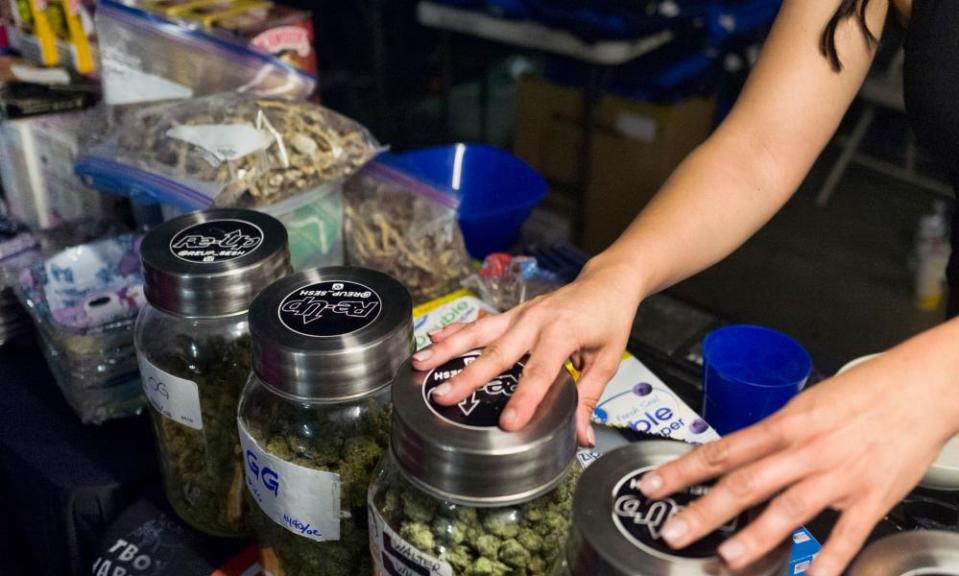A new study shows more Americans are dropping acid. Why?

In 1995, Jerry Garcia, singer/guitarist of the Grateful Dead and a figure almost singularly associated with America’s psychedelic subculture, died. Then something weird happened: a nationwide downturn in LSD consumption. It was no coincidence. As the author Jesse Jarnow notes in Heads: A Biography of Psychedelic America, for decades the Grateful Dead’s expansive, coast-to-coast live concert infrastructure was “the distribution network for LSD”. No Jerry meant no Dead tours, which meant, for many, no LSD. Garcia’s death effectively signalled the end of the Psychedelic Sixties.
Related: Twisting my melon, man! The baggy, brilliant indie-rave summer of 1990
But now, drugs like LSD and psilocybin (the active ingredient in magic mushrooms) are enjoying a vogue. They’re finding second lives as clinical tools in the pharmacological battle against depression and anxiety. They’re also being illicitly gobbled in sub-hallucinogenic “micro-doses” as daily supplements, reportedly boosting energy and creativity. In November, Oregonians will vote on whether to legalize psilocybin therapy statewide. And a new study in the July issue of the international journal Drug and Alcohol Dependence reports that LSD use increased 56% between 2015 and 2018 (including a rather massive 223% increase among people aged 35 to 49). It’s all part of what’s being termed the “psychedelic renaissance”.
This revival is curious. It doesn’t seem to be about restoring the bygone heyday of hippie-era psychedelic culture, as renaissance art of the 14th century turned back to the glories of antiquity. For some, the sun setting on this subculture was just as well. The concept of “the sixties” – with its long hair and wide-eyed, pupil-dilated idealism – has sometimes proved an impediment. Michael Pollan, whose bestseller How To Change Your Mind popularized the current resurgence, notes that the very word psychedelic “carries a lot of countercultural baggage”. Mind-expansion, we’re being told, may be beneficial – but please leave the tie-dye shirts and frilly vests and marching teddy bear bumper stickers in the past.

It can all feel overstated, even anxious. As a millennial who has spent decades curious about – and frankly, envious of – the explosion of music, politics and mind-expansion that marked the 1960s youth culture, cleaving psychedelics from popular notions of psychedelia strikes me as a bit, well, sad. Sure, images of twirling hippies muddied up at Woodstock can scan as a bit naive, or just annoying. But that conception of naivety was largely imposed after the fact, by cynics and moralizing conservative politicians. Unfortunately, it remains by and large the order of the day.
In this respect, the new study on America’s up-ticking LSD use carries a kernel of optimism. As its lead author, the University of Cincinnati’s Andrew Yockey, told Scientific American, “LSD is used primarily to escape. And given that the world’s on fire, people might be using it as a therapeutic mechanism.”
The new psychedelia is of a distinctly pharmacological character, mixing rigorous science with the woolier jargon of “self-care”. But the talk of escapism jives more with LSD’s explosion in the sixties. The counterculture of that period reacted against the perceived “straightness” of postwar America, the posturing strongman leaders, the endless conflicts abroad. Psychedelics, with their perceived pro-social effects, stirred feelings of togetherness, and provided a mental space for conceiving of some alternative.
As Yockey noted, his new study’s parameters were designed in part to track potential drug-taking responses to Trump’s 2016 election. (Yockey also told Scientific American that, in the wake of the Covid-19 outbreak, LSD usage has “probably tripled”.) Against such abounding bleakness, psychedelics can catalyze a profound rejigging of ones worldview.
LSD is used primarily to escape. And given that the world’s on fire, people might be using it as a therapeutic mechanism
Andrew Yockey
This promise of better living through chemistry feels pitched to our present moment: whether it be in contempt for heads of state, the demands for racial justice, or the more generalized anxiety that the world has gone horribly wrong. Another recent study, analyzing drug trends in the New York City dance scene, also showed an uptick in LSD usage, echoing the role of psychedelics in catalyzing sixties-era outdoor music festivals, rock concerts, and other hedonistic “happenings”.
It’s tempting to overstate the potential of these compounds. If there’s one count on which the 1960s psychedelic subculture is rightly arraigned, it’s drawing some crude, causal relationship between drug taking and political revolution. Even Timothy Leary, the era’s most outspoken psychedelic spokesman, would later confess that “[t]he use of any drug that takes your mind away from the basic issue, which is liberation-revolution, must be postponed”. Psychedelics may ease anxiety, increase empathy and expand the mind’s capacity to conceive of some better world; actually building that world has proved tougher work.
Nevertheless, a historical failure to manifest an ideal should not discredit the ideal itself, nor the culture that sprouted to support it. For many invested in psychedelia, then and now, the expanded horizon of political possibility and countercultural action isn’t inconvenient “baggage”. It’s the very essence of the trip.
Anyone bothered that psychedelics are being normalized, or assimilated within an existing for-profit pharmaceutical model – or just straight-up squared – may take comfort in studies suggesting that psychedelia’s countercultural spirit seems alive and well. In the words of a popular T-shirt peddled at amphitheater parking lots and music festival merch tables: Jerry Lives!
John Semley is a freelance writer and the author of Hater: On the Virtues of Utter Disagreeability

 Yahoo News
Yahoo News 
